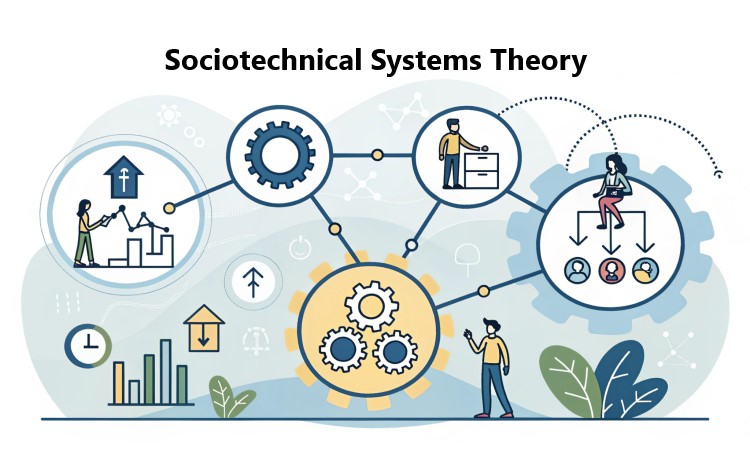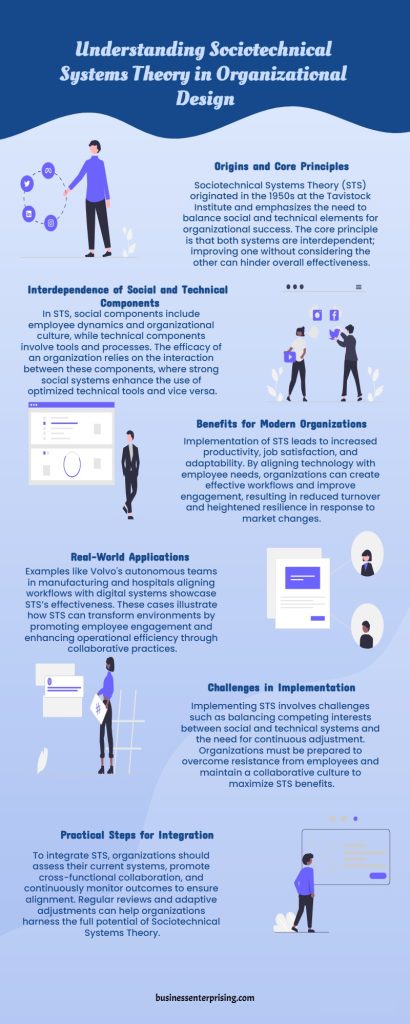 Sociotechnical Systems Theory offers a balanced approach to organizational design by integrating social and technical components. Developed in the 1950s, this theory emphasizes the importance of aligning both human and technical systems for optimal success. Rather than focusing solely on technology or people, Sociotechnical Systems Theory shows you how these elements interact and depend on each other. By adopting this perspective, you can create a work environment that not only boosts productivity but also enhances employee engagement. This theory is especially relevant in today’s complex, rapidly changing workplaces, where adaptability and collaboration are essential. Understanding and applying STS can help you create a resilient, efficient organization that meets the needs of both employees and operations.
Sociotechnical Systems Theory offers a balanced approach to organizational design by integrating social and technical components. Developed in the 1950s, this theory emphasizes the importance of aligning both human and technical systems for optimal success. Rather than focusing solely on technology or people, Sociotechnical Systems Theory shows you how these elements interact and depend on each other. By adopting this perspective, you can create a work environment that not only boosts productivity but also enhances employee engagement. This theory is especially relevant in today’s complex, rapidly changing workplaces, where adaptability and collaboration are essential. Understanding and applying STS can help you create a resilient, efficient organization that meets the needs of both employees and operations.
Introduction to Sociotechnical Systems Theory: Origins and Core Principles
Sociotechnical Systems Theory (STS) emerged in the 1950s, developed by researchers at the Tavistock Institute in London. This theory introduced a fresh perspective on organizational design, emphasizing the need to balance social and technical elements. STS suggests that success depends on optimizing both the social and technical systems, rather than focusing on one aspect alone.
The foundational principle of Sociotechnical Systems Theory is the interdependence between people and technology within organizations. According to STS, you can’t improve one system in isolation without affecting the other. When you integrate social aspects—such as teamwork, communication, and job satisfaction—with technical elements—such as workflows, machinery, and digital tools—you create a more effective, adaptable organization.
STS aims to create systems that empower employees while maximizing productivity. By jointly optimizing social and technical aspects, you build a workplace that adapts well to change and promotes employee engagement. As organizations face complex challenges, the principles of Sociotechnical Systems Theory remain highly relevant, guiding you in creating a balanced, efficient, and resilient environment.
Social and Technical Components of STS: Understanding Interdependence
In Sociotechnical Systems Theory, the social and technical components of an organization are deeply interconnected. The social elements include your employees, team dynamics, and organizational culture. These factors influence how people communicate, collaborate, and feel about their work. When your team members are engaged and supported, they contribute more effectively.
On the other hand, the technical components encompass the tools, technologies, and processes you use to get work done. These include machinery, software systems, and workflow designs. Technical elements shape how efficiently tasks are completed and how well resources are utilized. When your technical systems are well-designed, they enhance productivity and reduce errors.
However, the real strength of Sociotechnical Systems Theory lies in understanding how these social and technical systems interact. For example, even the most advanced technology won’t yield results if your team isn’t trained or motivated to use it. Conversely, a highly motivated team may struggle if the technical tools are outdated or inefficient. Therefore, you need to balance both aspects to achieve optimal performance.
By recognizing this interdependence, you can create an environment where technology supports your people, and your people make the most of technology. This synergy leads to increased productivity, better job satisfaction, and greater adaptability. When you align social and technical components, your organization becomes more resilient and effective.
Benefits of Sociotechnical Systems Theory for Modern Organizations
Sociotechnical Systems Theory offers significant benefits for modern organizations by enhancing productivity, job satisfaction, and adaptability. When you integrate social and technical components, you create a system that boosts overall performance. This approach ensures that technology aligns with employees’ needs, enabling them to work more efficiently. As a result, tasks are completed faster, and resources are used effectively.
Another advantage of Sociotechnical Systems Theory is its positive impact on job satisfaction. By considering the human aspect, you design work environments that support employees’ well-being and personal growth. When your team members feel valued and empowered, they are more motivated and engaged. This increased engagement leads to better retention rates, reducing the time and cost of hiring new talent.
STS also fosters adaptability, a crucial factor for success in today’s rapidly changing world. With a flexible and responsive system, you can adjust processes quickly in response to new challenges or opportunities. This adaptability allows your organization to remain resilient, staying ahead in competitive markets. By applying Sociotechnical Systems Theory, you build an organization that thrives through a balanced, people-centered approach.
Examples of Sociotechnical Systems Theory in Action
Sociotechnical Systems Theory has been successfully applied in various organizations to enhance efficiency and employee engagement. One notable example is Volvo’s use of STS in its car manufacturing plants. Traditionally, car manufacturing involved repetitive tasks, which often led to low employee morale and high turnover. Volvo implemented Sociotechnical Systems Theory by forming small, autonomous teams responsible for entire stages of car assembly. This approach empowered employees, giving them more control and reducing repetitive work. As a result, productivity increased, and employees reported higher job satisfaction.
Another example is the application of STS in healthcare settings. Hospitals have complex systems with numerous technical and social components. In one case, a hospital introduced Sociotechnical Systems Theory by aligning medical staff workflows with new digital health record systems. Rather than simply implementing the technology, the hospital worked with healthcare professionals to adapt the system to fit their routines. This collaborative approach reduced errors, improved patient outcomes, and increased staff satisfaction by integrating technology with everyday processes.
Additionally, the U.S. Postal Service applied STS principles to modernize its sorting facilities. By involving workers in designing workflows and choosing tools, they created a system that optimized both technical efficiency and worker engagement. As a result, the postal service achieved faster processing times and reduced workplace stress. These examples show how Sociotechnical Systems Theory can transform organizations by fostering a collaborative environment where social and technical elements work seamlessly together.
Challenges and Limitations of Implementing Sociotechnical Systems Theory
Implementing Sociotechnical Systems Theory (STS) in an organization presents several challenges. One major difficulty is balancing competing interests between social and technical systems. While technology may streamline certain processes, it can also create added pressure on employees. Finding the right balance between efficiency and employee well-being requires careful planning. You must prioritize both elements without allowing one to overshadow the other, which can be complex and time-consuming.
Another limitation of STS is the need for continuous adjustment. Social and technical components are dynamic, changing as your organization evolves. This means that a solution that works now may need adjustments later. Regularly updating systems to maintain balance between these components demands resources, time, and commitment. Without a strong focus on adaptability, your STS-based approach may struggle to keep up with rapid organizational changes.
Moreover, applying Sociotechnical Systems Theory requires a collaborative culture. You need to engage employees at all levels, which may not always be straightforward. Some employees may resist involvement in decision-making processes, while others may feel overwhelmed by added responsibilities. Navigating these potential sources of resistance involves open communication and continuous support. While STS offers valuable benefits, its successful implementation relies on careful management and a willingness to adapt along the way.
Practical Steps to Integrate Sociotechnical Systems Theory in Your Organization
Integrating Sociotechnical Systems Theory into your organization begins with assessing your social and technical systems. Start by examining workflows, technology, team dynamics, and employee roles. Identify areas where either the social or technical side may need improvement. This initial assessment gives you a clear picture of how both elements interact and where adjustments could enhance productivity and engagement.
Next, foster cross-functional collaboration to support the balance between social and technical aspects. Encourage teams from different departments to work together, bringing diverse perspectives to problem-solving. By collaborating across functions, your employees gain a deeper understanding of how their roles impact the larger organization. This teamwork helps align technical tools with actual workflows, ensuring both systems work together effectively.
Finally, continuously monitor outcomes to maintain alignment between social and technical components. Regularly review processes to see how changes impact productivity, employee satisfaction, and adaptability. Gather feedback from team members on how the system supports or hinders their work. Adjustments may be necessary as the organization evolves, so make monitoring a routine part of your approach. By following these steps, you can successfully integrate Sociotechnical Systems Theory, creating a balanced system that drives both performance and employee satisfaction.
Conclusion
Sociotechnical Systems Theory offers a valuable approach to creating balanced, adaptable organizations. By integrating social and technical components, you can boost productivity and employee satisfaction. While implementing STS requires ongoing attention and flexibility, the benefits are worth the effort. This theory helps you navigate complex organizational challenges by fostering collaboration and aligning systems with real work needs. Ultimately, Sociotechnical Systems Theory can guide your organization toward sustainable success, building a structure that supports both technological efficiency and a positive work culture.


